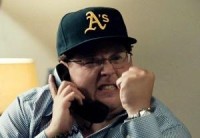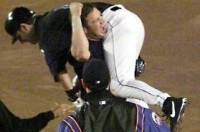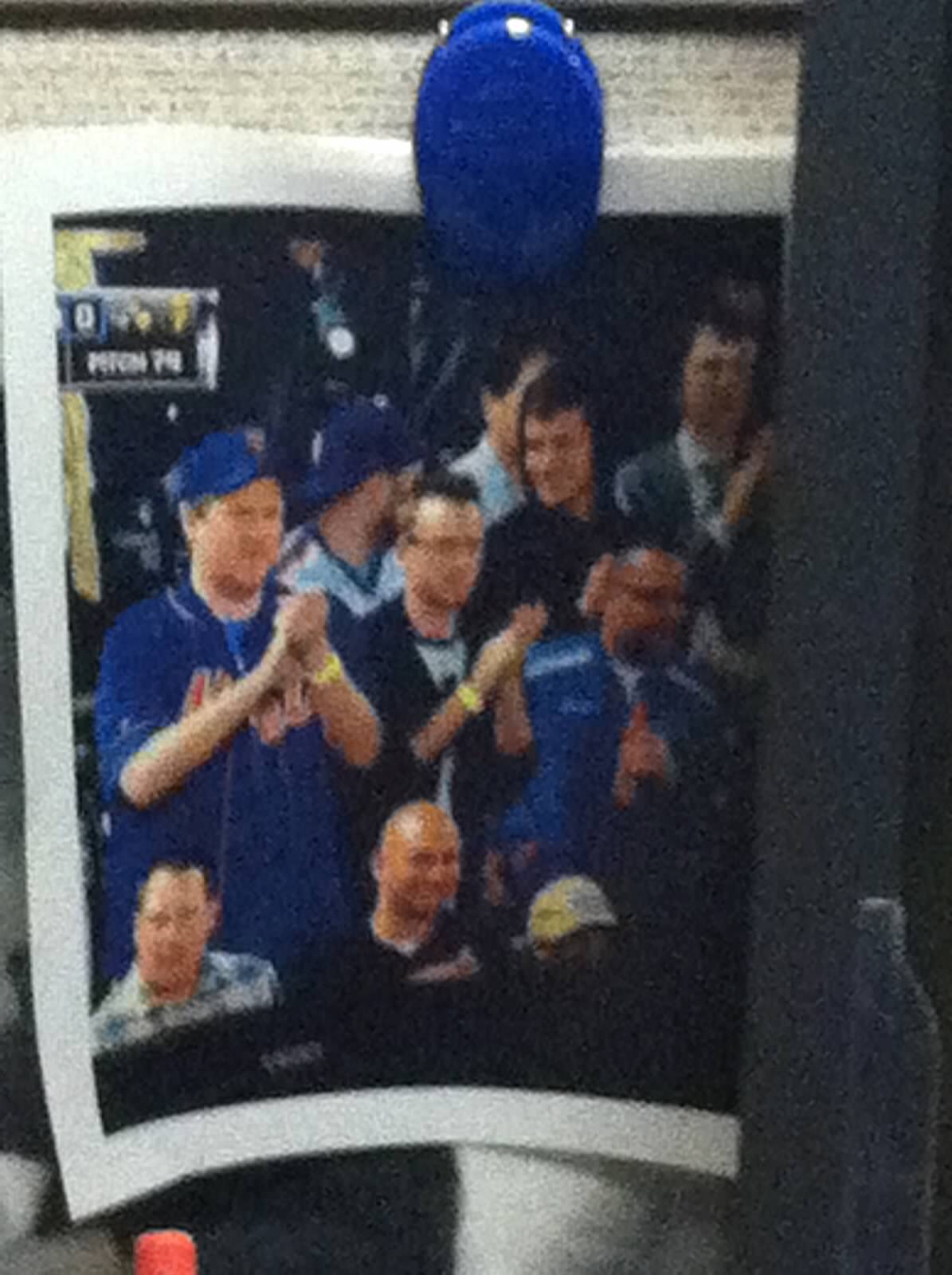Jason Isringhausen

From what I gather from reading incorrect interpretations of the book, I take many people did not actually read Moneyball. If you haven’t, you should go and read it. If you have, now is the time to re-read it.
The reason to re-read it now is the script for the Mets postseason lies within those pages. I know Sandy Alderson was no longer the A’s GM at the time; it was Billy Beane. However, remember Beane’s top two lieutenants were J.P. Riccardi and Paul DePodesta. Until recently, they were Alderson’s top lieutenants. They were at least in place when the Mets were creating their offseason plans.
One of the many aspects of the book, which the movie seemed to get purposefully wrong, was how the A’s went about replacing Jason Giambi and one-year rental Johnny Damon. In essence, the A’s determined they flat out didn’t have enough money to replace these guys with other high priced players. Instead, the A’s were going to have to replace their production using a different line of thinking. I’m summing up here and being a little over simplistic, but here was the thought process:
- The team needed to identify what was undervalued on the free agent market (OBP);
- They needed the cumulation of their entire roster to replace Giambi and Damon since they couldn’t just sign two big name free agents to do it; and
- They needed to do it as cheaply as possible.
So what did they do? Well we know the Scott Hatteberg story with him being moved to first due to his traditionally high OBP (more on that later). In the movie and most other places, the story behind the David Justice acquisition is plain wrong. The A’s obtained him from the Mets, not the Yankees, in exchange for a LOOGY by the name of Mark Guthrie and a mistake waiting to happen by the name of Tyler Yates. It was the Mets, not the Yankees, who kicked in salary. It was only $1.2 million.
Now for the moves that haven’t received much fanfare. The A’s handed the secondbase job to a young Mark Ellis, who was capable of higher production than last year’s second baseman Frank Menechino. Menechino was moved to the bench to create a deeper roster. The A’s traded for Carlos Pena, who was a promising young player. Pena was supposed to be the first baseman with Hatteberg at DH and Justice in LF. That’s the way it was up until the trade deadline. They also traded for Billy Koch to sure up the closer’s role for the departed Jason Isringhausen.
By design, the A’s replaced Giambi and Damon not only with Pena and Justice, but by also improving their DH spot (Olmedo Saenz and Jeremy Giambi) and secondbase. In essence, the A’s added three new starters putting their old starters on the bench. The A’s left some payroll flexibility and had assets for the trade deadline.
The A’s used Pena in a three way trade to acquire Ted Lilly to sure up the rotation behind their three young big pitchers. They then used a prospect to acquire Ray Durham to DH with some needed cash. Hatteberg moved to be the full time first baseman. And yes, like in the movie, the A’s also added Ricardo Rincon to be the LOOGY to sure up the bullpen.
Did it work? If you look at the record, it absolutely did. They went from a 102 win team to a 103 win team. However, the reason wasn’t Hatteberg or Rincon. No, the part we forget is Barry Zito won the Cy Young, and Miguel Tejada win the MVP. They were powered by an insane 20 game winning streak. Lost in that streak was the A’s played only one team over .500 and played two teams that lost over 100 games that year.
The 2002 A’s got top notch performances from their top guys, and they made sure to beat the teams they were supposed to beat. Make no mistake. The 2002 A’s were worse. They scored 84 less runs and allowed nine more runs. However, at the end of the day, it didn’t matter. They won one more game.
The Mets are in a similar position as the A’s were. Make no mistake about it, the Mets have limited funds. With those funds, they needed to go out and replace the production of Daniel Murphy and a half a season of Yoenis Cespedes. Last year, Murphy hit .281/.322/.449 with 14 homers and 73 RBI. Cespedes hit .287/.337/.604 with 17 homers and 44 RBI in his time with the Mets.
We already know how the Mets replaced that production. They traded for Neil Walker, who hit .269/.328/.427 with 16 homers and 71 RBI. He’s a career .272/.338/.431 hitter. The Mets then decided to go with a platoon in center. There is in-house option Juan Lagares to hit against lefties. He hit .273/.333/.438 against lefties last year and .279/.325/.427 for his career. Platooning with him is Alejandro De Aza, who hit .278/.351/.448 against righties last year and .274/.338/.418 for his career. Now, this isn’t enough to replace the production of both of Murphy and Cespedes.
That’s where Asdrubal Cabrera comes in. Last year, Wilmer Flores played the bulk of time at shortstop hitting .263/.295/.408. Ruben Tejada played a lot there hitting .261/.338/.350. The Mets hoped by signing Cabrera they have significantly upgraded the position to cover the loss of Murphy and Cespedes. Cabrera hit .265/.315/.430 last year with the Rays. Speaking of replacing Cespedes’ second half production Cabrera hit .328/.372/.544 in the second half last year. Tangentially, the bench is theoretically better by having Flores and Tejada there.
Following the script they invented in Oakland, the Mets have already done what they believe they needed to do to replace the production they have lost. Right now, the Mets projected payroll is ~$106 million or about $4 million less than the 2015 payroll. Accordingly, the Mets are maintaining payroll flexibility like the A’s did so they can make trades at the deadline.
And, by the way, the Mets are powered by their three big young starters. How will it work out in 2016? We don’t know yet. However, if history is any lesson, the 2016 Mets will be worse than the 2015 version. If they want to have a better record, the 2016 Mets will need to take advantage of their games against bad teams like the Phillies and Braves. One of the young pitchers will have to step up even more. We’ll see which everyday player can step up to have the Tejada-like season.

Rarely, if ever, do you see the Mets go all-in on a season. In fact, the only time I remember it happening was 1999 when Steve Phillips traded everyone to try to improve the team after just missing out on the playoffs in 1998.
Watching that 1999 team was probably the most fun I had watching baseball. With that season came so many highlights including the Al Leiter two-hitter in the Wild Card play-in game, Pratt’s All Folks, and the Grand Slam Single. The season ended cruelly with Kenny Rogers . . . .
If you remember, that year the Mets gave away Jason Isringhausen for Billy Taylor. As we know Taylor had no regular season impact and was left off the playoff roster. It also saw Octavio Dotel get called up too soon and stay in the majors too long to the tune of a 5.38 ERA. He was warming in the bullpen when Kenny Rogers . . . .
This year, the Mets are seemingly all-in like they were in 1999. They gave up their two best prospects who have not appeared in the majors this year. In exchange the Mets received two and a half months of Tyler Clippard and Yoenis Cespedes, who is leaving as a free agent. Because of deplorable offense, Michael Conforto was rushed to the majors, and the Mets won’t send him back down.
Look, I understand going all-in. It led to a run in 1999, and to a certain extent 2000. However, in order to go all-in, you don’t hedge your bets.
For starters, that means ending the innings limits nonsense. First of all, the underlying theorem was proven incorrect. Second, the rotation is set up nicely the rest of the year if it’s left unadulterated. Third, Steven Matz must go to the bullpen upon his return from the DL.
If the Mets make the playoffs, he will be in the bullpen anyway (if he makes the postseason roster). He can be like the 2006 Adam Wainwright or the 2008 David Price out there. This will help him and the Mets. If you put him in the rotation, you mess up the rotation and you endanger the opportunity that Matz can be effective in the postseason as a reliever.
If the Mets are truly all-in as their trades and treatment of Conforto suggest, Matz will be a reliever. If the Mets put him in the rotation and try spot starts or a six man rotation in September, then they should’ve sent down Conforto. You can’t go half way in being all-in.
Let’s hope no matter what they do, it works out to their benefit. Let’s also hope we’re talking potential postseason roster moves instead.

Admittedly, I have been apoplectic over the Tyler Clippard trade. The reason is because the last time the Mets made a trade like this it ended very badly. Faith and Fear in Flushing invoked the infamous John Smoltz and Jeff Bagwell trades. For me, it reminded me of Billy Taylor.
In 1999, the Mets were in competition for the playoffs for really the second time in my life (and second year in a row). I was too young to truly remember this (although my first baseball memory is the Buckner game) or this. After the previous season’s collapse, I was desperate to see the Nets make the playoffs. I was appreciative when Steve Phillips was aggressive at the trade deadline. Notably, he added Kenny Rogers (I still don’t want to talk about it), Shawn Dunston, and Darryl Hamilton (RIP). He also traded for Billy Taylor.
To acquire Billy Taylor, the Mets sent Billy Beane’s A’s Greg McMichael and Jason Isringhausen. At the time, I loved the move. Over a three year stretch, he had 73 saves on mediocre Athletics teams. In 1999, on an A’s team on the rise, he had 26 saves (his peripherals were awful but I didn’t follow such things back then). I was giddy at the prospect of the Mets having a 7-8-9 of Billy Taylor-John Franco-Armando Benitez (this is before we knew he was terrible in October). I didn’t care about the cost. All I wanted was a playoff berth, let alone a World Series.
Boy, was I wrong. In 18 appearances, Taylor had an 8.10 ERA. He was terrible. He didn’t pitch in the postseason. He was gone at the end of the year. He was out of baseball after the 2001 season.
The real cost of Taylor’s 18 innings? Jason Isringhausen’s career. He was once part of the fabled Generation K. In 1999, he was only given five starts. Mostly, he was a seldom used reliever who bounced between Norfolk and New York. He was coming off an elbow injury. At the time of the trade, he had a 6.41 ERA. His star had fallen. While he wasn’t good, Bobby V didn’t want to put him in the bullpen because that was “akin to using an Indy car as a taxi.”
I love Bobby V, but he was proven wrong. In 1999, he would save eight games for the A’s with a 2.13 ERA. That might’ve been helpful as Kenny Rogers walked in the winning run. Since the trade, Izzy accumulated 299 saves (one for the Mets in 1999 and seven for them in 2011). That was a lot to give up for 18 appearances.
Now, I don’t think Tyler Clippard will be as bad as Billy Taylor. He’s a much better pitcher. In actuality, through all of my hand wringing, I have noted Clippard is a quality addition that will help a back of a bullpen that needs it. I think the 7-8-9 of Bobby Parnell-Tyler Clippard-Jeurys Familia could be very good, or at least better than the 1999 version. If the Mets win the World Series, I’ll be thrilled and I won’t care how good Casey Meisner becomes.
However, I shudder at another Mets trade with Billy Beane for a reliever. While I hope one day I’m regaling my son of the 2015 championship season, I’m afraid that I will be explaining how Casey Meisner could have been a Met.
I know where I was three years ago. I was sitting in front of the TV in my basement watching Matt Harvey make his major league debut against the Arizona Diamondbacks. It was important to watch that game because it was the first glimmer of hope Mets fans since the collapses closing out Shea.
It’s been a whirlwind since then. He started by striking out Gerardo Parra (yes, that Gerardo Parra) in a record setting 11 K, 5.1 inning shutout win. He would finish 3-5 with a 2.73 ERA in 10 starts. He showed us glimpses of his potential.
In 2013, he started out like gangbusters. From the outset, he was the NL Player of the Week and April’s Player of the Month. He was in ESPN’s “The Body” issue. He almost had a perfect game (my second SNY appearance):

He had the epic Jimmy Fallon appearance. He then became the youngest All Star Game starter since Dwight Gooden. The fact he did it at Citi Field was all the more special.
Then things started to turn sour. The Mets let him pitch through forearm tightness (paging Dr. Warthen). After he was shut down, he fought seemingly everyone on getting the surgery (because the Mets should control anyone’s medical decisions). Now all of a sudden his Rangers fandom was a problem (because hanging around and learning from Lundqvist is a bad thing). He had the gaul to want to be around his teammates during his rehab. He had the audacity to seek to pitch one inning in 2014.
There were other missteps, some true and some overblown. Overblown: him paying respects to Derek Jeter. He wasn’t allowed to travel with the team. He goes and watches Derek Jeter’s home game (as inconspicuously as he could), and he gets blasted. By the way, we want our players to love and respect the game, and when Harvey does it, he’s vilified. The real ones were the social media gaffes.
Finally, 2015 mercifully arrived. He has been a very good starting pitcher, but not quite Matt Harvey yet. For his part, Harvey thinks he’s back. Let’s hope he is because I can’t stand the inane backlash from his travel arrangements to his being curteous after playing a round of golf. I can’t stand it.
You know what I see when I see Matt Harvey? I see a fierce competitor. I see a good teammate. I see someone who has handled fame and pressure well. He’s always at his locker answering questions, win or lose. I see a player whose nightlife activities include Ranger games. You don’t hear about all night drinking or drugs with him. After the 80’s, we should appreciate that.
On top of the lessons of the ’80’s Mets, we should remember the lessons of Generation K. The Mets were supposed to have three aces in Isringhausen, Pulsipher, and Wilson. That blew up rather quickly. We need to revere these pitchers while we have them (and while they are healthy).
For those of you who have read this blog before, my favorite player was Darryl Strawberry. My brother’s favorite player was Dwight Gooden. Trust me, that lead to some awkward conversations down the road with my Dad; conversations I frankly don’t want to ever have.
I hope my son grows to root for Harvey because: 1) he has so many positive traits to celebrate (competitiveness, accountability, he’s not a quitter); and 2) it means he will be effective with the Mets for a long time. I’m celebrating this day because it’s the anniversary of when the Mets started turning things around. I hope you are as well.